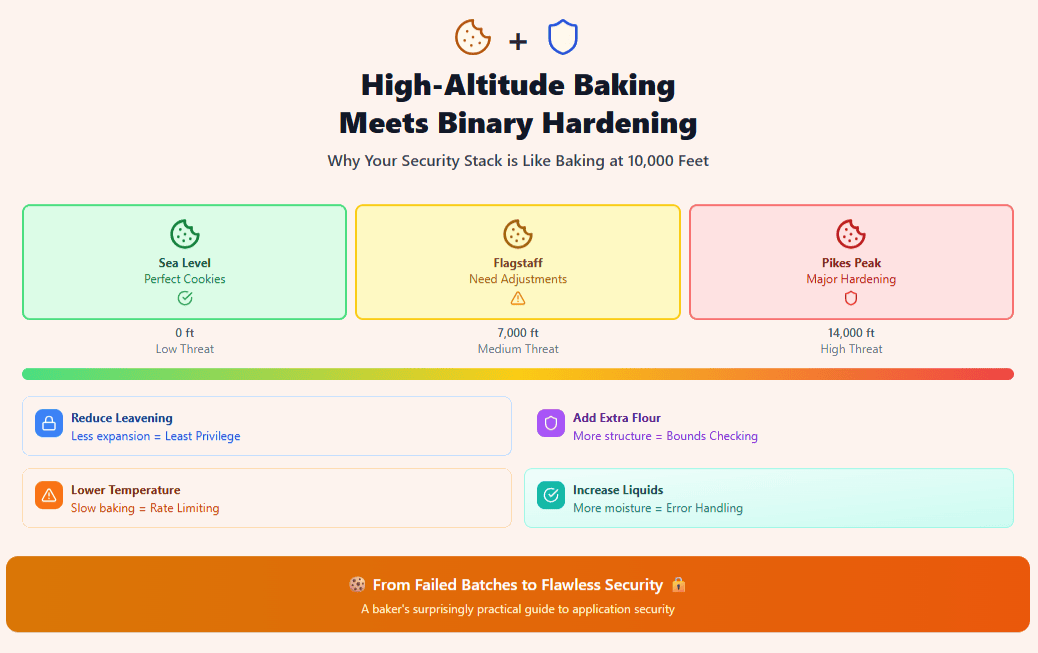Table of Contents
The Hostile Environment Problem
When Good Recipes Go Bad: Common Failure Patterns
Recipe Adjustments: Binary Hardening Techniques
Test Batches: The Importance of Security Testing
The Altitude Matters: Know Your Threat Environment
Bringing It All Together: My Perfect Cookie Recipe (And Security Stack)
Table of Contents
The Hostile Environment Problem
When Good Recipes Go Bad: Common Failure Patterns
Recipe Adjustments: Binary Hardening Techniques
Test Batches: The Importance of Security Testing
The Altitude Matters: Know Your Threat Environment
Bringing It All Together: My Perfect Cookie Recipe (And Security Stack)
Related Blogs
Last weekend, I spent three hours trying to bake the perfect batch of chocolate chip cookies at my home in Flagstaff. Three batches. Three disasters. Spreading like pancakes, rising too fast and collapsing, burning on the edges while staying raw in the middle. My sea-level recipe had completely failed me.
Sound familiar, security engineers?
As I stared at my third failed batch, it hit me: high-altitude baking is the perfect analogy for application security. Both involve taking something that works perfectly in ideal conditions and hardening it to survive in a hostile environment. Let me explain.
The Hostile Environment Problem
At sea level, atmospheric pressure is 14.7 psi. At 7,000 feet in Flagstaff, it drops to about 11.5 psi. This seemingly small difference wreaks havoc on baking chemistry. Water boils at lower temperatures. Gases expand faster. Moisture evaporates more quickly. Your tried-and-true recipe becomes a liability.
In application security, your code faces a similarly hostile environment. Instead of low pressure, you’re dealing with attackers probing for vulnerabilities, memory exploits waiting to be triggered, and buffer overflows ready to cascade. A binary that works perfectly in your controlled development environment can fail catastrophically when exposed to the wild.
The lesson? Recipes designed for ideal conditions will always fail under pressure. You need hardening.
When Good Recipes Go Bad: Common Failure Patterns
Problem 1: Spreading Too Thin (Information Disclosure)
At high altitude, cookies spread excessively because gases expand too quickly and structural proteins don’t set fast enough. The dough can’t hold its shape.
In security terms, this is like memory leaks and information disclosure vulnerabilities. Your application expands beyond its intended boundaries, leaking data into adjacent memory spaces. Sensitive information “spreads” where it shouldn’t, exposing secrets, session tokens, or user data to potential attackers.
The fix? Just as bakers add extra flour to provide structure, developers need bounds checking and strict memory management to contain execution.
Problem 2: Rising Too Fast Then Collapsing (Stack Overflow)
High-altitude cookies often rise dramatically in the first few minutes, then collapse into dense, flat discs. The leavening agents work too aggressively before the structure can support the expansion.
This is your classic stack overflow vulnerability. Uncontrolled growth of the call stack, recursive functions without proper termination, or buffer overflows that push beyond allocated memory. The application expands rapidly until it catastrophically fails.
The fix? Reduce the leavening. In security, this means implementing stack canaries, limiting recursion depth, and enforcing the principle of least privilege. Don’t let processes expand beyond what they absolutely need.
Problem 3: Burnt Edges, Raw Center (Uneven Security Coverage)
At altitude, the rapid moisture evaporation means edges burn while centers stay undercooked. You get uneven execution.
In applications, this manifests as comprehensive security on your public-facing APIs while internal services remain vulnerable. Perimeter security is strong, but lateral movement goes unchecked. You’ve hardened the obvious entry points but left the interior soft.
The fix? Lower your baking temperature and bake longer. In security, this means defense in depth, assume breach mentality, and uniform hardening across your entire stack, not just the edges.
Problem 4: Dry and Crumbly (Brittle Code)
Rapid moisture loss at altitude creates dry, crumbly cookies that fall apart when touched.
Brittle code behaves similarly. It works under narrow conditions but breaks unpredictably under stress. Edge cases cause crashes. Unexpected input leads to undefined behavior. There’s no resilience.
The fix? Add more liquid to retain moisture. For code, this means comprehensive error handling, graceful degradation, and resilience patterns. Your application should bend under pressure, not shatter.
Recipe Adjustments: Binary Hardening Techniques
Now let’s talk about the actual modifications needed. Here’s where the analogy gets really interesting.
Adjustment 1: Reduce Leavening (Principle of Least Privilege)
High-altitude bakers reduce baking soda and baking powder by 25-50%. Less expansion = more control.
In binary hardening:
- Run processes with minimum required permissions
- Drop capabilities after initialization
- Use seccomp filters to restrict system calls
- Implement role-based access control (RBAC)
Your application should do the bare minimum it needs to function. Every unnecessary privilege is a potential attack vector.
Adjustment 2: Add Extra Flour (Input Validation & Bounds Checking)
Extra flour provides structure and absorbs excess moisture. It contains the spread.
In security:
- Validate all inputs against strict schemas
- Implement buffer overflow protections (stack canaries, ASLR)
- Use memory-safe languages where possible
- Enable compiler protections (DEP, CFG, SafeSEH)
This is your structural integrity. It prevents your application from expanding into dangerous territory.
Adjustment 3: Lower Temperature, Increase Time (Rate Limiting & Controlled Execution)
Baking at lower temperatures prevents edges from burning while the center catches up.
For applications:
- Implement rate limiting on APIs
- Use progressive delays for authentication attempts
- Control resource consumption with quotas
- Sandbox untrusted code execution
Slow down attackers. Make exploitation time-consuming and resource-intensive.
Adjustment 4: Increase Liquids (Error Handling & Resilience)
Extra liquid compensates for rapid evaporation and prevents brittleness.
In code:
- Comprehensive exception handling
- Circuit breaker patterns
- Fallback mechanisms
- Graceful degradation strategies
Your application should survive unexpected conditions. When one component fails, it shouldn’t bring down the entire system.
Adjustment 5: Chill the Dough (Staging & Sandboxing)
Refrigerating dough for 24-72 hours before baking allows flavors to develop and fats to solidify, giving you more control during baking.
For security:
- Staged rollouts with monitoring
- Sandbox new features before full deployment
- Use containerization and isolation
- Test in production-like environments
Give your hardening time to solidify before full exposure to the hostile environment.
Test Batches: The Importance of Security Testing
Here’s what every baker knows: you don’t get it right on the first try. You bake test batches. You measure results. You adjust variables. You iterate.
The same applies to security:
Penetration Testing = Your first test batch. See what breaks.
Fuzzing = Throwing random variations at your recipe. What happens with unexpected inputs?
Security Audits = Having another baker review your recipe. Fresh eyes catch what you miss.
Continuous Monitoring = Tasting cookies from every batch. Just because batch 100 was good doesn’t mean batch 101 will be.
The Altitude Matters: Know Your Threat Environment
Not all applications operate at the same “altitude.” A command-line tool on an air-gapped network is at sea level. A public-facing financial API is at 14,000 feet on Pikes Peak.
Adjust your hardening accordingly:
Low Threat (Sea Level): Standard compiler protections, basic input validation
Medium Threat (5,000-8,000 ft): Add ASLR, DEP, stack canaries, comprehensive logging
High Threat (8,000+ ft): Full memory-safe languages, formal verification, runtime monitoring, zero-trust architecture
Don’t over-engineer a simple internal tool, but don’t under-engineer a critical public service. Know your altitude.
Bringing It All Together: My Perfect Cookie Recipe (And Security Stack)
After many failed batches, here’s what works for me at 7,000 feet:
- 25% less baking soda (reduced privileges)
- 2 extra tablespoons flour (bounds checking)
- Chill dough 48 hours (staging)
- Bake at 350°F instead of 375°F (rate limiting)
- Extra vanilla extract (error handling adds flavor when things go wrong)
And here’s my hardened binary checklist:
✅ Compile with -fstack-protector-strong, -D_FORTIFY_SOURCE=2, -Wl,-z,relro,-z,now
✅ Enable ASLR and DEP
✅ Implement strict input validation
✅ Run with minimal privileges
✅ Add comprehensive logging and monitoring
✅ Use memory-safe string functions
✅ Test with fuzzing and static analysis
✅ Stage rollouts with canary deployments
The Bottom Line
Whether you’re baking cookies or building secure applications, the principle is the same: recipes that work in ideal conditions will fail in hostile environments. You need to understand your threat landscape, anticipate failure modes, and harden your approach accordingly.
The good news? Just like high-altitude baking, binary hardening follows predictable patterns. Once you understand the adjustments needed, you can apply them systematically.
The bad news? There’s no universal recipe. You need to know your altitude, test relentlessly, and be willing to iterate.
But here’s what I know for sure: a security engineer who thinks like a high-altitude baker, understanding that environment shapes outcomes and that hardening is essential, will build more resilient systems.
Now if you’ll excuse me, I have some perfectly fluffy cookies to eat. And some binaries to harden.
Your Recipe for Success: The Right Tools Matter
Here’s the thing about high-altitude baking: once you understand the science, having the right tools makes all the difference. A good oven thermometer tells you the real temperature. A kitchen scale gives you precision. Quality ingredients produce consistent results.
The same is true for application security.
Understanding the principles I’ve outlined above is crucial, but implementing comprehensive binary hardening and application security at scale requires enterprise-grade tools. That’s where Digital.ai Application Security comes in.
Just like I needed to modify multiple aspects of my cookie recipe simultaneously (less leavening, more flour, lower temp, longer chill time), modern application security requires a holistic approach. Digital.ai provides exactly that—comprehensive protection that addresses the entire attack surface of your applications, from code to runtime. It’s like having a master baker’s recipe book, but for security: battle-tested techniques, automated adjustments, and continuous monitoring to ensure your applications stay resilient in even the most hostile environments.
And remember that “dry and crumbly” problem—the brittleness that comes from inadequate protection? One of the most critical areas where applications become brittle is in their communication streams. Your data might be perfectly secured at rest and your binaries perfectly hardened, but if your communication channels are vulnerable, it’s like baking perfect cookies and then dropping them on the floor during transport.
That’s where Digital.ai Key Data Protection becomes essential. It secures your communications stream with military-grade encryption and key management, ensuring that data in transit is just as protected as data at rest. Think of it as the airtight container that keeps your cookies fresh during delivery—all that work hardening your recipe means nothing if the cookies get crushed or contaminated on the way to your customer.
Together, these solutions give you the “extra liquid” your security recipe needs: the resilience, the comprehensive coverage, the defense-in-depth that prevents your applications from becoming brittle and breaking under pressure.
Because at the end of the day, whether you’re baking at altitude or building secure applications, you need:
- The right recipe (security principles and architecture)
- The right adjustments (hardening techniques tailored to your threat environment)
- The right tools (enterprise solutions that scale with your needs)
- Continuous testing (because the environment is always changing)
Get these elements right, and you’ll have perfectly fluffy cookies every time. Or in our case, rock-solid secure applications that can withstand whatever the hostile environment throws at them.

Want to learn more about hardening your applications? Check out our solutions—we've got the recipe down.
Explore
What's New In The World of Digital.ai
Why Your Security Stack is Like Baking Cookies at 10,000 Feet (And How to Stop Them From Falling Flat)
Last weekend, I spent three hours trying to bake the…
The Return to Bare Metal: Why We’re Done Pretending
For the better part of two decades, we’ve been sold…
How Common Is Code Obfuscation in Popular Android Apps?
Whether the goal is to steal intellectual property, gain access…




